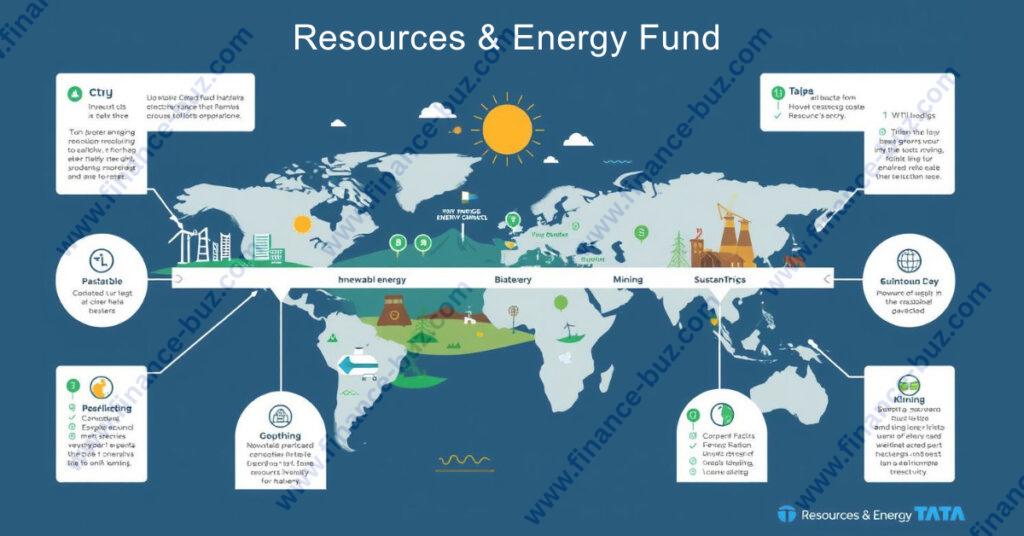India’s shift towards renewable energy has sparked a significant interest in the financial market, with investors looking for opportunities to support sustainable solutions. As the world moves towards greener alternatives, several Indian companies are at the forefront of this movement, creating a favorable environment for investments in clean energy.
The government’s initiatives to promote renewable energy development have further boosted the growth of mutual funds focused on this sector. Investors are now seeking the best options to diversify their portfolios while contributing to a sustainable future.
Key Takeaways
- Overview of top clean energy mutual funds available in India
- Understanding the growth potential of renewable energy investments
- Government initiatives supporting clean energy development
- How to choose the right mutual fund for your financial goals
- Impact of global sustainability trends on Indian clean energy investments
Understanding Clean Energy Mutual Funds
As the world shifts towards sustainable energy, clean energy mutual funds have emerged as a popular investment option. These funds allow individuals to invest in a diversified portfolio of companies focused on renewable energy sources, such as solar, wind, and hydroelectric power.
What Are Clean Energy Mutual Funds?
Clean energy mutual funds are investment vehicles that pool money from multiple investors to purchase securities in companies operating in the clean energy sector. These funds differ from traditional energy sector funds by focusing on environmentally sustainable energy production and distribution companies. By investing in clean energy mutual funds, individuals can support the transition to a more sustainable energy mix.
The Growing Importance of Green Energy Investments
The importance of green energy investments is growing rapidly due to increasing concerns about climate change and the need for sustainable energy solutions. Clean energy investments represent both an environmental commitment and a strategic financial opportunity as the world transitions away from fossil fuels. By investing in clean energy mutual funds, individuals can participate in the clean energy revolution without needing specialized knowledge of individual companies in the sector.
The Clean Energy Landscape in India
India’s clean energy sector is experiencing rapid growth, driven by government initiatives and technological advancements. This growth is reflected in the increasing capacity for renewable energy, with ambitious targets set for solar, wind, and other clean energy sources by 2030.
Current State of Renewable Energy in India
India has emerged as one of the world’s fastest-growing renewable energy markets, creating significant investment opportunities in the sector. The country’s renewable energy capacity has been expanding rapidly, with a focus on solar and wind energy. Renewable energy mutual funds are benefiting from this trend, offering investors a way to tap into the growing clean energy market.
Government Policies Supporting Clean Energy
The Indian government has implemented several policies to support the growth of clean energy, including the National Solar Mission and renewable purchase obligations. These initiatives, along with tax incentives, have created a favorable environment for clean energy companies, potentially benefiting investors in related energy mutual funds. The government’s commitment to reducing carbon emissions and increasing renewable energy capacity aligns with global climate goals, creating long-term growth potential for the sector.
Top Clean Energy Mutual Funds in India
Clean energy mutual funds have emerged as a popular investment option in India, offering a way to capitalize on the country’s renewable energy boom. These funds provide investors with a diversified portfolio of companies involved in clean energy production, distribution, and infrastructure.
ICICI Prudential Energy Opportunities Fund

The ICICI Prudential Energy Opportunities Fund targets investment opportunities in the energy and power sector, seeking long-term capital appreciation. This fund implements a growth-focused strategy, appealing to investors interested in energy-related assets. With a strong track record, it has become a popular choice among investors looking to tap into India’s clean energy growth.
SBI Energy Opportunities Fund

The SBI Energy Opportunities Fund focuses on the energy and power sector, capitalizing on growth opportunities within energy production, distribution, and infrastructure. This fund is designed for investors seeking exposure to India’s energy market, with a strategy aimed at long-term wealth creation.
Nippon India Power & Infrastructure Fund

Nippon India Power & Infrastructure Fund invests in power and infrastructure companies, particularly those involved in renewable energy. The fund’s strategy is geared towards long-term wealth creation, making it an attractive option for investors looking to benefit from India’s infrastructure and clean energy growth.
DSP Natural Resources & New Energy Fund

The DSP Natural Resources & New Energy Fund adopts a unique investment strategy, focusing on both natural resources and renewable energy companies. This approach provides investors with exposure to sustainability-focused technologies and companies driving the transition to cleaner energy sources.
Tata Resources & Energy Fund

Tata Resources & Energy Fund follows a growth-oriented approach to investments in resource and energy sectors. The fund benefits from developments in energy production and resource management, offering investors a way to tap into the growth potential of India’s energy market.
Baroda BNP Paribas Energy Opportunities Fund

The Baroda BNP Paribas Energy Opportunities Fund has been launched with a focus on energy sector companies across traditional and renewable segments. The fund aims for long-term capital appreciation, providing investors with a diversified portfolio of energy-related assets.
These top clean energy mutual funds in India offer investors a range of options to capitalize on the country’s transition to renewable energy. By investing in these funds, investors can benefit from the growth potential of the clean energy sector while diversifying their portfolios.
Performance Analysis of Clean Energy Mutual Funds
Analyzing the historical performance of clean energy mutual funds is crucial for understanding their potential for future growth. Clean energy mutual funds have been gaining traction due to their potential for high returns and alignment with sustainable investment goals.
Historical Returns
Clean energy mutual funds in India have delivered impressive returns over the past few years. The average annualized return over three years stands at approximately 20.83%. This growth indicates the potential of these funds for long-term investors. Energy mutual funds are particularly suited for aggressive investors who can tolerate some level of risk.
Benchmark Comparisons
To understand the performance of clean energy mutual funds, it’s essential to compare them against relevant benchmarks like the NIFTY Energy Index. This comparison helps investors gauge the returns and volatility of these funds. By examining how clean energy funds perform during different market cycles, investors can better understand their risk-return profile.
Clean energy mutual funds have shown resilience and growth potential, making them an attractive option for investors looking to capitalize on the renewable energy sector. However, their focused nature means they carry higher risk, and investors should be aware of this when making investment decisions.
Benefits of Investing in Clean Energy Mutual Funds
The benefits of investing in clean energy mutual funds are multifaceted, including diversification, sustainability, and growth potential. These funds offer investors a unique opportunity to participate in the rapidly evolving renewable energy sector.
Diversification Advantages
Investing in top renewable energy mutual funds in India can provide exposure to both conventional energy companies and emerging renewable sectors. This diversification helps spread risk across different types of assets, potentially leading to more stable returns. By investing in a range of companies throughout the clean energy value chain, from equipment manufacturers to power producers and distribution companies, investors can benefit from the overall growth of the sector.
Sustainability and ESG Alignment
Clean energy investments align with Environmental, Social, and Governance (ESG) criteria, allowing investors to support sustainable initiatives while seeking financial returns. This alignment is increasingly important for investors who prioritize ESG considerations in their investment decisions. By investing in clean energy mutual funds, investors can contribute to the transition to a more sustainable energy mix.
Growth Potential in Renewable Sector
The renewable energy sector is poised for significant growth, driven by increasing global demand for clean energy solutions and supportive government policies. Investing in clean energy mutual funds positions investors to benefit from this growth trend. As governments continue to implement policies supporting renewable energy, the potential for long-term growth in this sector remains strong.
| Benefits | Description |
|---|---|
| Diversification | Exposure to both conventional and renewable energy sectors |
| Sustainability | Alignment with ESG criteria and support for sustainable initiatives |
| Growth Potential | Benefiting from the increasing demand for clean energy solutions |
Risks Associated with Clean Energy Investments
The growing interest in sustainable investing has led to a surge in clean energy mutual funds in India. While these investments offer numerous benefits, they also come with certain risks that investors should be aware of.
Also Read: How to Create Passive Income in India for Beginners in 2025
Market Volatility Factors
Clean energy stocks can be more volatile than broader market indices due to their growth-oriented nature and sensitivity to energy price fluctuations. Market trends and economic conditions can significantly impact the returns on clean energy mutual funds.
Policy Dependence Risks
Changes in government regulations, subsidies, or environmental policies can significantly impact the performance of clean energy companies. Investors should be aware of the policy dependence risks associated with these investments.
Technological and Competition Risks
The renewable energy sector is rapidly evolving, with new technologies emerging regularly. This can lead to technological obsolescence and increased competition, affecting the profitability of clean energy companies.
| Risk Factor | Description | Impact on Investments |
|---|---|---|
| Market Volatility | Sensitivity to energy price fluctuations | High |
| Policy Dependence | Changes in government regulations and subsidies | Medium to High |
| Technological Obsolescence | Emergence of new, more efficient technologies | Medium |
How to Invest in Clean Energy Mutual Funds
As the world shifts towards renewable energy, investing in clean energy mutual funds has emerged as a viable option for Indian investors. Clean energy mutual funds provide a diversified portfolio that includes companies involved in renewable energy projects, energy efficiency, and sustainable infrastructure.
Lump Sum vs. SIP Investment Approach
Investors can choose between a lump sum investment and a Systematic Investment Plan (SIP) when investing in clean energy mutual funds. An SIP allows investors to invest a fixed amount at regular intervals, leveraging the benefit of rupee cost averaging. This approach can help mitigate the impact of market volatility on investment returns. In contrast, a lump sum investment involves investing a large amount at once, which can be beneficial if the market performs well.
Online Investment Platforms
Several online platforms offer clean energy mutual funds, making it easier for investors to start their investment journey. These platforms provide features such as easy account setup, SIP management, and portfolio tracking. Popular platforms include Kotak Mutual Fund, ICICI Prudential Mutual Fund, and SBI Mutual Fund. Investors should compare the features, user experience, and fee structures of these platforms before making a decision.
Taxation of Clean Energy Mutual Funds
Understanding the tax implications of clean energy mutual funds is essential for investors seeking to optimize their returns. The Union Budget 2024 has introduced significant changes to the taxation of equity mutual funds, including those focused on clean energy.
Short-Term Capital Gains Tax
For holdings of less than one year, the short-term capital gains tax rate is now 20%, increased from the previous 15%, with no indexation benefits. This change affects investors who frequently buy and sell clean energy mutual fund units.
Long-Term Capital Gains Tax
For holdings exceeding one year, there’s a tax-free limit of Rs. 1.25 lakh per financial year. Gains above this threshold are taxed at a flat rate of 12.5%. The removal of indexation benefits simplifies the calculation but may impact long-term investors.
| Investment Period | Tax Rate | Indexation Benefit |
|---|---|---|
| Less than 1 year | 20% | No |
| More than 1 year | 12.5% (above Rs. 1.25 lakh) | No |
Investors should consider these tax implications when planning their investments in clean energy mutual funds. It’s also advisable to consult with a financial advisor to optimize tax strategies.
Comparing Clean Energy Funds with Traditional Energy Funds
Clean energy funds and traditional energy funds represent two distinct approaches to investing in the energy sector, with different growth drivers and risk factors. While traditional energy funds invest primarily in fossil fuel companies, clean energy funds focus on renewable energy sources like solar, wind, and hydroelectric power.
Risk-Return Profile Differences
The risk-return profiles of clean energy funds and traditional energy funds differ significantly. Traditional energy funds are more sensitive to commodity price fluctuations, whereas clean energy funds are influenced by policy changes and technological developments. Investors should be aware of these differences when choosing between the two. For instance, traditional energy funds may offer more stable returns in the short term, but clean energy funds may provide higher growth potential in the long term due to increasing demand for renewable energy.
Future Growth Prospects
The future growth prospects for clean energy funds are promising, driven by global energy transition trends and climate policies. In contrast, traditional energy funds may face challenges due to declining demand for fossil fuels. As the world continues to shift towards cleaner energy sources, clean energy funds are likely to outperform traditional energy funds. This shift is expected to drive significant growth in the renewable energy sector, making clean energy funds an attractive option for investors looking for long-term returns.
Key Factors to Consider Before Investing
Understanding the key factors of clean energy mutual funds is essential for successful investment. Investors must evaluate several critical elements before deciding to invest in these energy mutual funds.
Fund Objective and Investment Strategy
The fund’s objective and investment strategy are crucial. Investors should look for funds that align with their investment goals and risk tolerance. A clear understanding of the fund’s strategy helps in assessing its potential for growth.
Expense Ratio and Fund Size
The expense ratio significantly impacts the fund’s returns. A lower expense ratio can lead to higher net returns for investors. Fund size is also important; very small funds may face liquidity issues, while very large funds might struggle with agility.
| Fund Name | Expense Ratio | Fund Size (Crores) |
|---|---|---|
| ICICI Prudential Energy Opportunities Fund | 1.25% | 1200 |
| SBI Energy Opportunities Fund | 1.50% | 1500 |
| Nippon India Power & Infrastructure Fund | 1.10% | 1800 |
Fund Manager Expertise
The expertise of the fund manager is vital in the specialized clean energy sector. An experienced fund manager can significantly impact the fund’s performance by making informed investment decisions.
Who Should Invest in Clean Energy Mutual Funds
To benefit from clean energy mutual funds, investors need to have a specific risk profile and investment horizon. These funds are designed for those who can withstand the inherent volatility of the clean energy sector while seeking potentially higher returns.
Investor Profile and Risk Tolerance
Clean energy mutual funds are most suitable for investors with a higher risk tolerance. As “The clean energy sector is known for its growth potential, but it also comes with significant risks.” Investors should be able to digest the potential fluctuations in the market and not be averse to taking on some level of risk. A diversified portfolio can help mitigate some of this risk, with clean energy funds serving as a complementary allocation, typically representing no more than 10-15% of an investor’s total equity exposure.
Investment Horizon Recommendations
A long-term investment horizon is crucial when investing in clean energy mutual funds. Investors should have a time horizon of 5+ years to ride out short-term market fluctuations. As noted,
“Patience is key when investing in sectors that are prone to volatility.”
Younger investors or those with a longer time horizon may find clean energy mutual funds particularly appealing, as they can benefit from the growth potential of the sector while prioritizing environmental impact alongside financial returns.
Conclusion
As India continues its transition towards renewable energy, clean energy mutual funds have emerged as a vital investment avenue. These energy mutual funds offer a dual benefit: potential financial returns and contribution to environmental sustainability. While they come with associated risks, their long-term growth potential is significant as India embraces clean energy. Investors can consider these funds as part of a diversified portfolio, aligning with both financial goals and environmental values. By investing in clean energy mutual funds, investors can participate in India’s sustainable future.

Leave a Comment